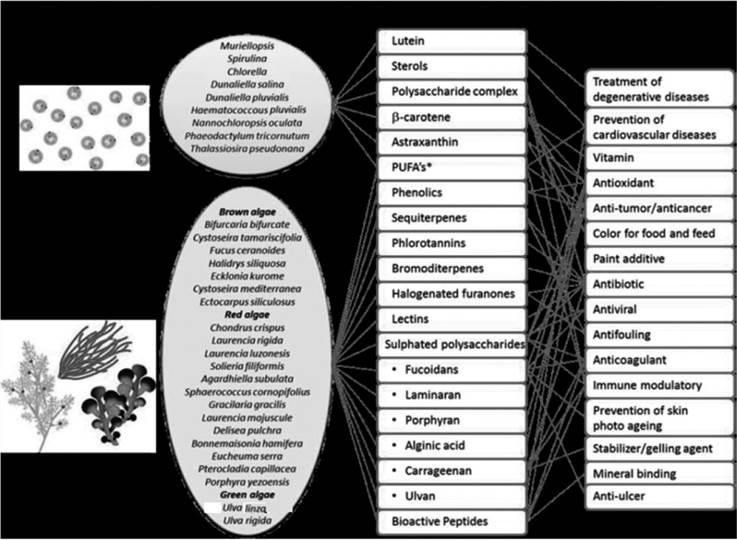In the last few years, macroalgae have been of increasing interest to many industries, such as fuels, plastics, cosmetics, pharmaceuticals, and food. Indeed, the chemical diversity in red (Rhodophyta), green (Chlorophyta), and brown (Phaeophyta) macroalgae offers the possibility of discovering a wide range of primary and secondary metabolites with interesting properties and applications. Primary metabolites (e.g., proteins, polysaccharides, and lipids) are directly involved in physiological functions. On the other hand, secondary metabolites (phenolic compounds, halogenated compounds, sterols, terpenes and bioactive compounds such as small peptides) are mainly excretion products produced under different stress conditions, such as exposure to ultraviolet (UV) radiation, changes in temperature and salinity or environmental pollutants. These secondary metabolites are considered to have great potential for developing new drugs.
 Fig 1. Components of secondary metabolites of marine algae and their possible application. (El-Beltagi H S, et al., 2019)
Fig 1. Components of secondary metabolites of marine algae and their possible application. (El-Beltagi H S, et al., 2019)
Seaweeds are a natural resource with a wide range of secondary metabolites. Our scientists evaluate these compounds extensively through bioassays and pharmacology. Our goal is to isolate, purify and identify secondary metabolites from different seaweed sources for applications. The four main groups of microalgal secondary metabolites are phenols, glycosides, alkaloids, and terpenoids. We try to develop these secondary metabolites for applications in different industries, including pharmaceuticals, flavorings, and disinfectants.
Lifeasible has extensive experience in all aspects of seaweed research. We focus on the isolation and characterization of glycosides and alkaloids from seaweeds. We are proud to offer custom services for identifying and characterizing seaweed secondary metabolites (glycosides and alkaloids).
(1) Sample Preparation
We identify samples based on their morphological characteristics and quickly powder them after simple treatment.
(2) Sample Extraction
We offer cold extraction of crude extracts from seaweed samples using methanol as the solvent.(3) Isolation and Purification of Secondary Metabolites
We can quickly obtain glycosides and alkaloids from seaweed crude extracts by thin layer chromatography (TLC) using a specific solvent system and purification of the seaweed extract by column chromatography.
(4) Identification of Secondary Metabolites
We offer gas chromatography-mass spectrometry (GC-MS) to identify purified glycosides and alkaloids. This is an analytical method for identifying different substances in test samples. It also helps to identify trace elements in samples.
(5) Application-Oriented Activity Tests
We offer a variety of tests to analyze their anti-microbial activity, antioxidant activity, and anti-diabetic activity.
Our solution for identifying seaweed secondary metabolites is designed to rapidly isolate and identify these beneficial secondary metabolites in seaweeds and to develop their role in different applications. Our customer service representatives are enthusiastic and trustworthy 24 hours a day, 7 days a week. If you are interested in our services, please feel free to contact us for more information or to discuss in detail.
Reference